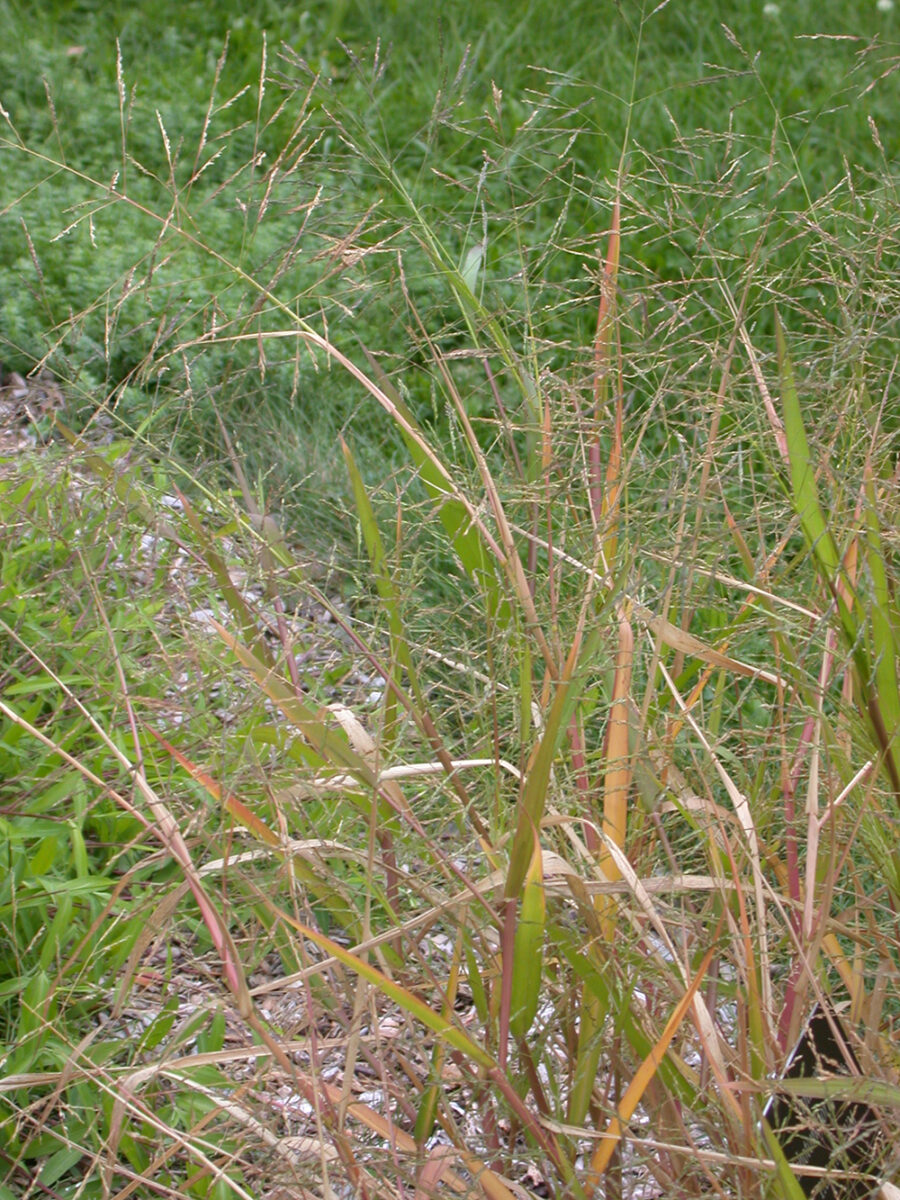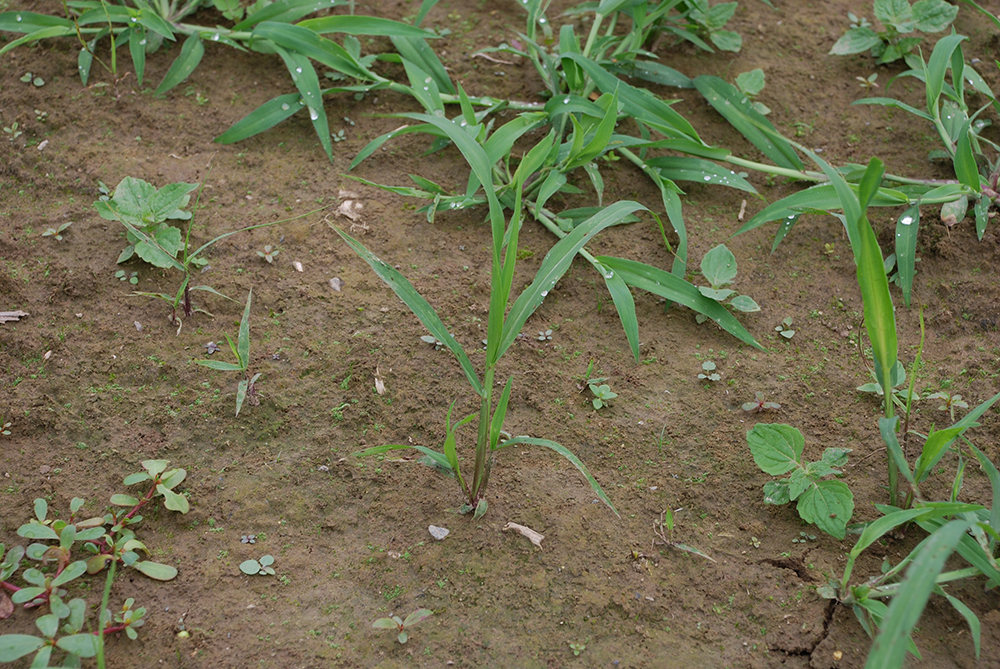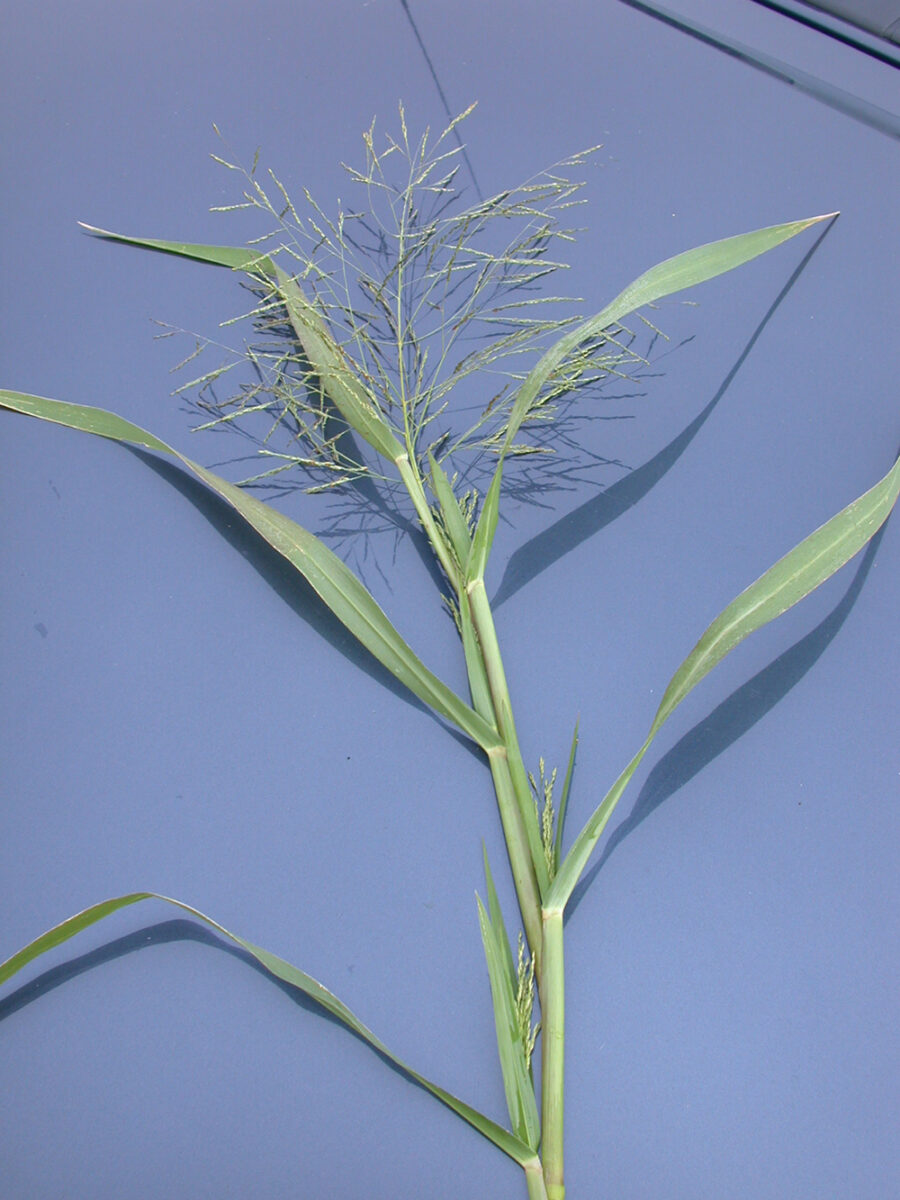Other common names: spreading witch grass, sprouting crab grass, smooth witchgrass, western witchgrass



Panicum dichotomiflorum Michx.
Identification of Fall Panicum
Family: Grass family, Poaceae
Habit: Large, erect, summer annual grass
Description: Seedlings often have a purple hue. Seed leaves and first true leaves are parallel to the ground, lanceolate to linear in shape and densely hairy on their undersides. True leaves are rolled in the bud and hairless after the fourth or fifth leaf stage. Hairy ligules are 0.06 inch long; auricles are absent. Blades are rough edged. Sheaths are compressed and hairy. Mature plants are largely hairless, reaching up to 5 feet tall. Stems are waxy with irregularly spaced, swollen nodes that give the stem a zigzagged appearance. Red-purple sheaths are compressed, smooth, hairless and open at the top. Collars are wide; ligules are densely hairy and 0.06 inch long. Blades are dull green with red edges, glossy undersides and lanceolate to linear, 4–20 inches long by 0.25–0.75 inch wide. Leaves have a pale green to white, prominent midvein. The root system is fibrous with spontaneous roots developing at lower stem-sheath joints. The inflorescence is a widely spaced, 4–16 inch long panicle with long, subdividing branches. Panicles are purplish at maturity and are located at stem ends and in leaf joints. Narrow, stiff stems support stalked, narrow spikelets at the branch tips. Spikelets are dull yellow to purple-hued, 0.10–0.12 inch long by 0.08 inch wide, and oval to thumb shaped. Spikelets each produce one dull, yellow-brown, 0.06 inch long seed.
Similar species: Yellow foxtail (Setaria pumila (Poir.) Roem. & Schult.) is similar at the seedling stage, but it has hairless sheaths and long wispy hairs near the blade base. Witchgrass (Panicum capillare L.) seedlings have hairs on both blade surfaces. Wild-proso millet (Panicum miliaceum L.) is distinguished from fall panicum by its half membranous, half hairy ligule.
Management of Fall Panicum
Crop rotation is a key element in controlling fall panicum. Since it does not germinate until the soil warms, either winter grains or early planted spring grains are highly competitive with this species. Also, leaf cover from well-established grain crops will keep soil temperatures cool and relatively constant, which will decrease germination. Moreover, both fall and spring sown grains are harvested before fall panicum sets seed. Post-harvest cleanup or a competitive interplanted cover crop like red clover can prevent seed set, particularly if the cover crop is mowed when fall panicum begins to flower. Set the mower at about 4–5 inches; the goal is to sever the young flowering stalks but leave the cover crop enough tissue to regrow quickly and smother the weed. Since the seeds do not persist well in the soil, rotation with hay is helpful in suppressing this species. In vegetables, any short season crop that is harvested before fall panicum begins to set seed in late summer will disrupt the life cycle, provided the field is cleaned promptly after harvest.
For row crops, tine weed pre- and post-emergence, and throw soil into the row to cover seedlings if the crop will tolerate such a procedure. If possible, cultivate shallowly close to the row. Severing the root from the shoot with minimal soil disturbance may be more effective than excavating or burying this weed. Unless cultivation is effective, long season row crops are likely to favor fall panicum.
Avoid soil compaction, as this favors fall panicum. Similarly, if the field has drainage problems, drain tile or other measures to improve drainage will increase the competitiveness of crops relative to the weed.
Ecology of Fall Panicum
Origin and distribution: Fall panicum is native to North America. It occurs throughout the United States, Mexico and the West Indies, and it has been introduced throughout the more humid parts of southern Canada. Its status as a native in much of the western United States seems doubtful.
Seed weight: 0.2–0.9 mg.
Dormancy and germination: Seeds are dormant when shed due to the tight, hard chaff. Four to five months of after-ripening or two weeks of cold, moist conditions breaks this dormancy. Even when this first level of dormancy is relieved, the seeds still require light to germinate and either high temperatures or day/night temperature fluctuations in the range of 68/50°F to 95/68°F to germinate. Seeds are only capable of dark germination when dug up in mid-summer months and are exposed to a day/night temperature fluctuation of 95/68°F. Fall panicum seeds require high soil moisture for germination. For example, germination of this weed is more sensitive to moderately dry soil than is corn or common lambsquarters.
Seed longevity: Two percent of seeds germinated after 10 years of burial at 9 inches under sod in Nebraska. Seeds buried at 8 inches in silt loam and gravelly loam in Ontario declined by 39% and 56% per year over a 4.5-year period. Seeds buried more shallowly disappeared faster, partially due to seedling emergence.
Timing of emergence: Fall panicum emerges primarily in mid- to late-spring in the South and mid-spring to mid-summer in the North, but some plants emerge throughout the growing season.
Emergence depth: Fall panicum emerges best from the soil surface to 1 inch, but a few seedlings can emerge from as deep as 3 inches.
Photosynthetic pathway: C4
Sensitivity to frost: This species is sensitive to frost. Seeds fall from the plant after the first frost.
Drought tolerance: This species tends to be favored by moist conditions. Emergence and seedling survival were enhanced by supplemental irrigation that alleviated droughty conditions.
Mycorrhiza: There are no reports of the mycorrhizal status of fall panicum, but other Panicum species are mycorrhizal.
Response to fertility: Increasing rates of 10-10-10 fertilizer promoted growth of fall panicum between corn rows where competition was reduced. Conditions were favorable for corn growth in this experiment, and competition from the crop prevented a noticeable fertility response by the weed within rows. Potassium concentration was lower in plants growing in the row than between the rows.
Soil physical requirements: Fall panicum occurs on soils with a wide range of textures, but it does best on fine textured and organic soils. Fall panicum is an indicator of anaerobic, compacted soils. It tolerates waterlogged and salty soils.
Response to shade: Shade from crops can substantially decrease biomass, height and seed production and can increase maturation rate.
Sensitivity to disturbance: Cutting seedlings just below the base of the shoot kills them, so shallow tillage that severs seedlings should be effective at controlling this species.
Time from emergence to flowering: Plants emerging in early May in Wisconsin flowered in about three months. Time to flowering and seed set decreases with later emerging plants. For example, in Massachusetts, plants emerging in late May required 116 days to set seed, whereas plants emerging in late July required only 74 days.
Pollination: Fall panicum is wind pollinated.
Reproduction: Typical plants growing in the field in Massachusetts produced 500,000 seeds per plant. Production of 10,000–100,000 seeds per plant may be more usual for larger plants. Seed production under competition from a mixed community of weeds will range from 100–300 seeds per plant.
Dispersal: As plants commonly grow near water and the seeds float, the seeds probably disperse in waterways. Fall panicum seeds are spread with cattle manure. Given the high density of seeds sometimes found in the soil, seeds probably also spread with soil clinging to tires, shoes and machinery.
Common natural enemies: The specialist smut fungus (Ustilago destruens) can greatly reduce seed production of fall panicum.Palatability: People do not eat fall panicum. At the vegetative stage, fall panicum can provide ruminants with nutrient levels similar to cultivated grasses. The species can cause nitrate poisoning and photosensitivity in livestock.
Summary Table of Fall Panicum Characteristics
| Fall Panicum | ||||||||
|---|---|---|---|---|---|---|---|---|
| Growth habit | Seed weight (mg) | Seed dormancy at shedding | Factors breaking dormancy | Optimum temperature for germination (F) | Seed mortality in untilled soil (%/year) | Seed mortality in tilled soil (%/year) | Typical emergence season | Optimum emergence depth (inches) |
| tall | 0.2–0.9 | Yes | cms, li, at | 68/50 to 95/68 | 39–56 | na | mid-spring to mid-summer | 0–1 |
| Photosynthesis type | Frost tolerance | Drought tolerance | Mycorrhiza | Response to nutrients | Emergence to flowering (weeks) | Flowering to viable seed (weeks) | Pollination | Typical & high seed production (seeds per plant) |
| C4 | low | low | probably | moderate | 7–13 | 3–4 | cross | 10,000 & 100,000 |
Table Key
General: The designation “–” signifies that data is not available or the category is not applicable.
Growth habit: A two-word description; the first word indicates relative height (tall, medium, short, prostrate) and second word indicates degree of branching (erect, branching, vining).
Seed weight: Range of reported values in units of “mg per seed.”
Seed dormancy at shedding: “Yes” if most seeds are dormant when shed, “Variable” if dormancy is highly variable, “No” if most seeds are not dormant.
Factors breaking dormancy: The principle factors that are reported to break dormancy and facilitate germination. The order of listing does not imply order of importance. Abbreviations are:
scd = seed coat deterioration
cms = a period subjected to cold, moist soil conditions
wst = warm soil temperatures
li = light
at = alternating day-night temperatures
ni = nitrates
Optimum temperature range for germination: Temperature (Fahrenheit) range that provides for optimum germination of non-dormant seeds. Germination at lower percentages can occur outside of this range. The dash refers to temperature range, and the slash refers to alternating day/night temperature amplitudes.
Seed mortality in untilled soil: Range of mortality estimates (percentage of seed mortality in one year) for buried seeds in untilled soil. Values were chosen where possible for seeds placed at depths below the emergence depth for the species and left undisturbed until assessment. Mortality primarily represents seed deterioration in soil.
Seed mortality in tilled soil: Range of mortality estimates (percentage of seed mortality in one year) for seeds in tilled soil. Values were chosen for seeds placed within the tillage depth and subjected to at least annual tillage events. Seed losses are the result of dormancy-breaking cues induced by tillage, germination and deterioration of un-germinated seeds.
Typical emergence season: Time of year when most emergence occurs in the typical regions of occurrence for each weed. Some emergence may occur outside of this range.
Optimum emergence depth: Soil depths (in inches below the soil surface) from which most seedlings emerge. Lower rates of emergence usually will occur at depths just above or just below this range.
Photosynthesis type: Codes “C3” or “C4” refer to the metabolic pathway for fixing carbon dioxide during photosynthesis. Generally, C3 plants function better in cooler seasons or environments and C4 plants function better in warmer seasons or environments.
Frost tolerance: Relative tolerance of plants to freezing temperatures (high, moderate, low).
Drought tolerance: Relative tolerance of plants to drought (high, moderate, low).
Mycorrhiza: Presence of mycorrhizal fungi. “Yes” if present; “no” if documented not to be present, “unclear” if there are reports of both presence and absence; “variable” if the weed can function either with or without, depending on the soil environment.
Response to nutrients: Relative plant growth response to the nutrient content of soil, primarily N, P, K (high, moderate, low).
Emergence to flowering: Length of time (weeks) after emergence for plants to begin flowering given typical emergence in the region of occurrence. For species emerging in fall, “emergence to flowering” means time from resumption of growth in spring to first flowering.
Flowering to viable seed: Length of time (weeks) after flowering for seeds to become viable.
Pollination: “Self” refers to species that exclusively self-pollinate, “cross” refers to species that exclusively cross-pollinate, “self, can cross” refer to species that primarily self-pollinate, but also cross-pollinate at a low rate, and “both” refers to species that both self-pollinate and cross-pollinate at relatively similar rates.
Typical and high seed production potential: The first value is seed production (seeds per plant) under typical conditions with crop and weed competition. The second value, high seed production, refers to conditions of low density without crop competition. Numbers are rounded off to a magnitude that is representative of often highly variable reported values.
Further Reading
Brecke, B.J. and W.B. Duke. 1980. Dormancy, germination, and emergence characteristics of fall panicum (Panicum dichotomiflorum) seed. Weed Science 28: 683–685.

